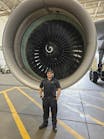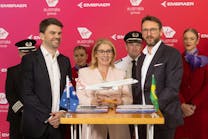Fleet Additions Down to 4-Yr Low in ‘22; Airfares To Remain Firm
Mar. 29—NEW DELHI — The induction of aircraft by Indian airlines fell to a four-year low in 2022, or 95% lower than 2021, resulting in high fares and raising concerns over the sustainability of record passenger growth in the domestic market.
Net fleet additions by airlines in 2022 shrank to just seven, compared to a net induction of 141 aircraft in 2021, according to government data seen by Mint. To be sure, while 82 planes were added in 2022, 75 were retired by airlines. Net additions were also lower compared to 2019 and 2020, when it stood at 35 and 45 aircraft.
Industry experts said capacity addition has been largely impacted by supply chain issues which delayed delivery of new aircraft, engines, and spare parts for IndiGo, Go First and Vistara. That apart, some carriers such as SpiceJet also faced financial issues and could not expand their fleet size.
The pace of supply was severely hit first by the covid-led lockdowns worldwide, disrupting manufacturing, and then by the global economic slowdown following the Russia- Ukraine war.
Industry analysts said the reduction in capacity addition at a time passenger numbers are at a record high and airlines expect a record summer season, is set to impact growth, as it will lead to higher fares.
"Constrained capacity means passengers must be ready to pay high fares compared to pre-pandemic levels in the near term. Limited capacity and high demand will lead to a surge in passenger load factor," said an industry expert, seeking anonymity.
The Indian aviation market has been an outlier in terms of growth in domestic passenger traffic. The daily air passenger level is hovering around 420,000-440,000 passengers even in a traditionally lean quarter, a jump from the pre-covid highs of 420,000 despite lower capacity of airlines compared to 2019.
The grounding of more than 100 aircraft due to a shortage of spare parts has added to capacity constraints of airlines that are witnessing passenger load factor or capacity utilization of just 90%, which is considered an unhealthy trend for the aviation sector in the long -run.
"You are turning down traffic with higher passenger load factor. A PLF of 85% is a reasonable number. High PLF restricts growth and fares at such load factors are considerably higher," an airline official said seeking anonymity.
Experts said the industry is set to witness high fares this year. "This decrease in capacity is bound to affect the supply-demand dynamics of Indian aviation. Air fares are likely to be higher in 2023 compared to 2022, as demand for air travel is expected to pick up in the coming months with the easing of visa procedures," said Nishant Pitti, chief executive officer and co-founder, EaseMyTrip, adding that the increase in jet fuel price and inflation will also impact fares.
While India's aviation market is highly competitive, with the entry of new players and falling capacity, airlines may shift focus from price-based competition to service-based differentiation, he said.
The operational fleet of Indian airlines is less than 600 planes, with over 100 grounded aircraft. Industry experts said if this capacity is operationalised, fares can be moderated and growth will kick in for the sector.
This problem of slow induction of aircraft is set to continue as manufacturers do not see any respite in the supply chain issues over the next two years.
"Supply chain is still going to take a couple of more years to heal," Boeing India President Salil Gupte had said earlier this month. For 2023, industry experts are confident that IndiGo, Air India, and Akasa Air will lead the net fleet addition in the Indian aviation industry.
___
(c)2023 the Mint (New Delhi)
Visit the Mint (New Delhi) at www.livemint.com
Distributed by Tribune Content Agency, LLC.


